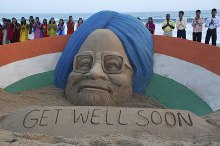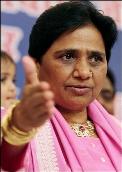Tempus
|
|
Tidskriften
|
 TO UNVEIL preparations for global
democracy’s greatest logistical feat, an Indian election,
representatives of 47 political parties were summoned to Delhi
on February 3rd. Sarong-wrapped Tamils, grey-trousered Communists
and north Indians in dhotis, rough-spun shawls and kurta-pyjamas,
costumes increasingly rare outside parliament these days, were
among them. Absent, alas, were the emissaries of a dazzling new
actor-politician, Chiranjeevi—an immortal of “Tollywood”,
the Telugu-language film industry of Andhra Pradesh—as election
officials ran through arrangements for a poll that is expected
to begin in April, extend over several weeks, and for which nearly
700m voters have been registered.
TO UNVEIL preparations for global
democracy’s greatest logistical feat, an Indian election,
representatives of 47 political parties were summoned to Delhi
on February 3rd. Sarong-wrapped Tamils, grey-trousered Communists
and north Indians in dhotis, rough-spun shawls and kurta-pyjamas,
costumes increasingly rare outside parliament these days, were
among them. Absent, alas, were the emissaries of a dazzling new
actor-politician, Chiranjeevi—an immortal of “Tollywood”,
the Telugu-language film industry of Andhra Pradesh—as election
officials ran through arrangements for a poll that is expected
to begin in April, extend over several weeks, and for which nearly
700m voters have been registered.
Adding to the drama was an ugly row between two of the officials themselves. N. Gopalaswami, head of India’s Election Commission, has been trying to sack his deputy, Navin Chawla, whom he accuses of bias in favour of the Congress party, which leads India’s ruling coalition. With Mr Chawla expected to take over from Mr Gopalaswami when he retires in April, Congress’s main opponent, the Bharatiya Janata Party (BJP), is predictably enraged. But Congress insists that Mr Chawla, an acolyte of its former leader, Indira Gandhi, stay put. Some fear the spat augurs an ill-tempered—even unjust—election.
India’s two main parties were already nervy. As at the pre-poll meeting, they find themselves in an increasingly crowded arena. Neither has a hope of winning an outright majority in the election. After decades in decline, Congress cobbled together a government in 2004 after winning 145 of a possible 543 seats—the lowest winning tally in any Indian election. Yet neither of the parties can be confident of beating this score. So, as important as the election’s outcome will be their subsequent race to recruit allies among the proliferating regional, caste-based and leftist parties. If neither of the big parties musters a majority that way, India’s next ruling coalition may even emerge from this horde.
Compared with the Hindu nationalists, Congress in fact seems quite perky. The reason why is not obvious. At the end of a five-year term, dominated by a booming economy, including a run of annual economic growth of 9%, the government has hit trouble. The economy is slowing; the IMF has forecast GDP growth of 5.6% in the financial year ending in April. Thousands of jobs have already been lost. The terrorist atrocity in Mumbai last November has also spread gloom. And the party’s septuagenarian prime minister and acting finance minister, Manmohan Singh, is incapacitated: off work for a month after undergoing heart bypass surgery on January 24th. In fact his absence has not caused much obvious disruption: a sign of how constrained he has been, at the helm of a massive and feuding coalition.
A result close to its 2004 performance would be creditable for Congress. It is likely to retreat in Andhra Pradesh, the state where it won most seats in 2004, and where the emergence of a new party under Mr Chiranjeevi, a star of 148 Telugu and Hindi films, will further divide the vote. Congress will hope to make good in, for example, Kerala, Rajasthan and Punjab. It needs to, since the prospects of some of its allies elsewhere are even worse. In Bihar and Tamil Nadu, Congress’s two biggest regional allies look set for a beating. The Communists, whose “outside” support propped up the government until they stalked away last year, are also expected to fare worse than in 2004. Partly to leave the door open for fresh “post-poll” alliances, after the votes are counted, Congress announced on January 29th that it would fight the election solo; though, as in 2004, it will form alliances state by state.
Mr Singh’s health is a worry for Congress. A conciliatory figure, he has been much criticised for his gentle leadership. Yet he has been more evident in recent months, securing the passage of a vaunted nuclear co-operation deal with America, and saying shrewd things about the world economy. Congress’s leader, Sonia Gandhi, who passed up the job of prime minister five years ago to forestall controversy over her foreign (Italian) birth, would like the loyal Mr Singh to remain prime minister until her gauche 38-year-old son, Rahul, is considered up to the job. If Mr Singh could not dust himself off for another year or two at the helm, it is not clear to whom Mrs Gandhi might turn.
The BJP also has leadership worries, but they go deeper. Shattered to lose power in 2004, the party has since been riven by feuding between its two main constituents, Hindu ideologues and secular free-marketeers. A string of state-election victories, and the nomination last year of L.K. Advani, a doughty octogenarian, as its prime-ministerial candidate had seemed to reverse the party’s decline. But after some disappointing state-election results in December, and recent incidents of terrorism and vigilantism by Hindu fundamentalist thugs, the party’s ideological chasm has reopened. And Mr Advani, despite launching a slick new blog, is suddenly seeming his age. The BJP rank-and-file, as well as many Indian industrialists, would prefer to follow Narendra Modi, a charismatic, fire-eating Hindu-chauvinist and chief minister of Gujarat, who has a reputation for efficient economic management, but was implicated in a pogrom against Muslims in 2002. If not in this election, Mr Modi’s time may come.
 On
current form, the BJP’s electoral prospects look no better
than Congress’s, which probably explains why its rival seems
oddly chipper. The logic of anti-incumbency, a rule of thumb in
predicting Indian elections, suggests the Hindu nationalists will
decline in several northern bastions, including Rajasthan and
Chhattisgarh. They must also fear a wipe-out in Uttar Pradesh
(UP), a giant northern state with 80 parliamentary constituencies,
which played a big part in propelling them to power in the 1990s.
The BJP fared miserably in UP’s 2007 state election, which
was swept by the Bahujan Samaj Party, an outfit dedicated to dalits,
Hinduism’s former “untouchables”, and led by a
mercurial and scandal-prone woman, Mayawati.
On
current form, the BJP’s electoral prospects look no better
than Congress’s, which probably explains why its rival seems
oddly chipper. The logic of anti-incumbency, a rule of thumb in
predicting Indian elections, suggests the Hindu nationalists will
decline in several northern bastions, including Rajasthan and
Chhattisgarh. They must also fear a wipe-out in Uttar Pradesh
(UP), a giant northern state with 80 parliamentary constituencies,
which played a big part in propelling them to power in the 1990s.
The BJP fared miserably in UP’s 2007 state election, which
was swept by the Bahujan Samaj Party, an outfit dedicated to dalits,
Hinduism’s former “untouchables”, and led by a
mercurial and scandal-prone woman, Mayawati.
To the joy of some 250m dalits, and the consternation of almost everybody else, Miss Mayawati hopes to claim the prime ministership for herself. She is one of two poles around which a non-Congress, non-BJP government might emerge. The other is a coalition of irritated former allies of both Congress and the BJP, including Communists and regionalists, and known as the “third front”. A currently fashionable theory is that, if both big parties do as modestly as many expect, Congress could choose to lend its parliamentary votes to such a government, rather than lead a weak administration in troubled times. What good this unstable arrangement might do India is rather hard to grasp